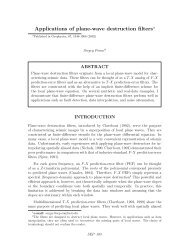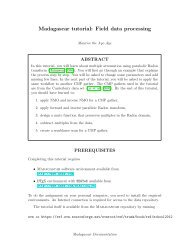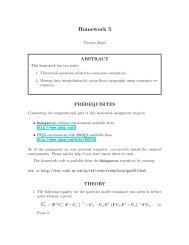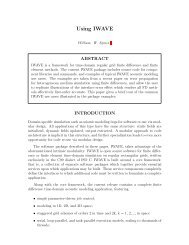Seismic wave extrapolation using lowrank symbol ... - Madagascar
Seismic wave extrapolation using lowrank symbol ... - Madagascar
Seismic wave extrapolation using lowrank symbol ... - Madagascar
You also want an ePaper? Increase the reach of your titles
YUMPU automatically turns print PDFs into web optimized ePapers that Google loves.
Fomel, Ying, & Song 17 Lowrank <strong>wave</strong> <strong>extrapolation</strong><br />
This theorem essentially says that projecting to a subspace of dimension O(log N)<br />
preserves the pairwise distance between N arbitrary vectors. There is an immediate<br />
generalization of this theorem due to Magen (2002), formulated slightly differently<br />
for our purpose.<br />
Theorem 2. Let v 1 , . . . , v N be a set of N vectors in R d . Let T be a randomly generated<br />
subspace of dimension t = O(r 3 log N/ε 2 ) and use P T to denote the orthogonal<br />
projection onto T . Then with high probability,<br />
( ) r/2 d<br />
(1 − ε) · vol r (v i1 , . . . , v ir ) ≤ vol r (P T v i1 , . . . , P T v ir ) ≤ (1 + ε) · vol r (v i1 , . . . , v ir )<br />
t<br />
for any {i 1 , . . . , i r } ⊂ {1, . . . , N}.<br />
The main step of the proof is to bound the singular values of a random matrix<br />
between (1 − ε) 1/r and (1 + ε) 1/r (after a uniform scaling) and this ensures that the<br />
r-dimensional volume is preserved within a factor of (1 − ε) and (1 + ε). In order<br />
to obtain this bound on the singular values, we need t to be O(r 3 log N). However,<br />
bounding the singular values is only one way to bound the volume, hence it is possible<br />
to improve the dependence of t on r. In fact, in practice, we observe that t only needs<br />
to scale like O(r log N).<br />
Given a generic subspace T of dimension t, computing the projections P T w 1 , . . . , P T w N<br />
takes O(tN 2 ) steps. Recall that our goal is to find an algorithm with linear complexity,<br />
hence this is still too costly. In order to reduce the cost of the random projection,<br />
the second idea of our approach is to randomly choose t coordinates and then project<br />
(or restrict) each vector only to these coordinates. This is a projection with much less<br />
randomness but one that is much more efficient to apply. Computationally, this is<br />
equivalent to restricting W to t randomly selected rows. We do not yet have a theorem<br />
regarding the volume for this projection. However, it preserves the r-dimensional<br />
volume very well for the matrix W and this is in fact due to the oscillatory nature of<br />
the columns of W. We denote the resulting vectors by { ˜w 1 , . . . , ˜w Nx }.<br />
The next task is to find a set of columns {j 1 , . . . , j r } so that the volume vol r ( ˜w j1 , . . . , ˜w jr )<br />
is nearly maximum. As we mentioned earlier, exhaustive search is too costly. To overcome<br />
this, the third idea is to use the following pivoted QR algorithm (or pivoted<br />
Gram-Schmidt process) to find the r columns.<br />
1: for s = 1, . . . , r do<br />
2: Find j s among {1, . . . , N} \ j 1 , . . . , j s−1 such that ˜w js has the largest norm<br />
3: Orthogonalize the vectors ˜w j for j ∈ {1, . . . , N}\j 1 , . . . , j s with ˜w js and update<br />
them<br />
4: end for<br />
5: {j 1 , . . . , j r } is the column set required<br />
Once the column set is found, we set U = [w j1 , . . . , w jr ].<br />
In order to identify V ∗ , one needs to find a set of r rows of W that has an almost<br />
maximum volume. To do that, we repeat the same steps now to W ∗ . More precisely,











